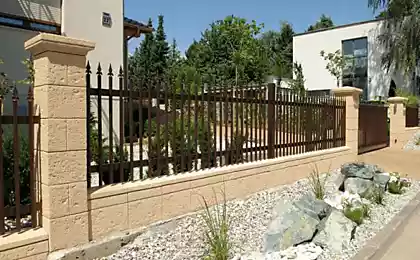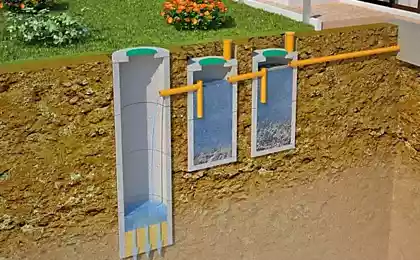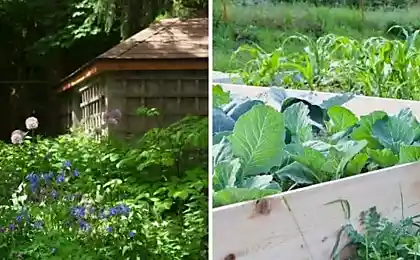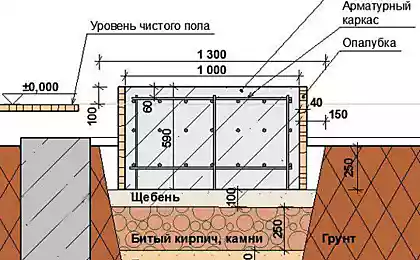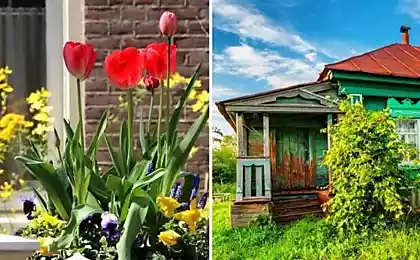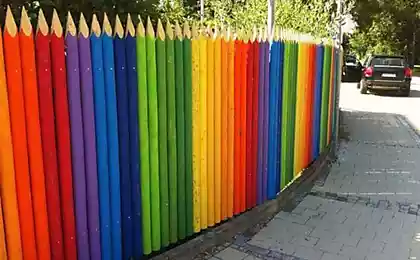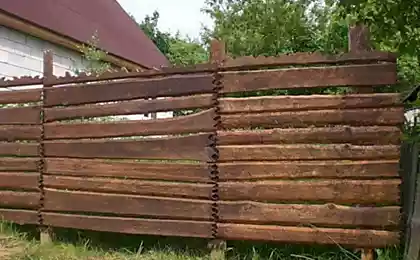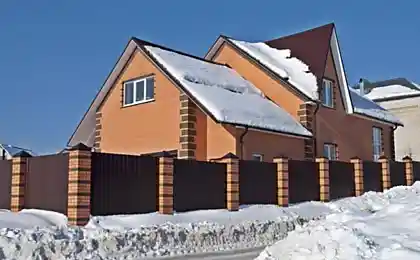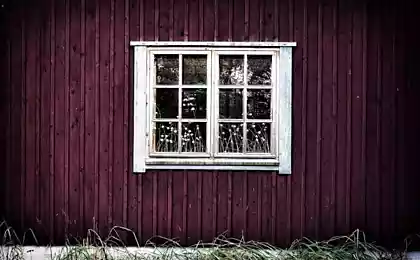601
How to make a decorative fence for garden
Wicker fence has long been considered one of the main types of the fence area. The technology of weaving is not as complex, so these fences were most common in ancient times. Today, he is a very interesting design element. How do you make a decorative fence for garden?
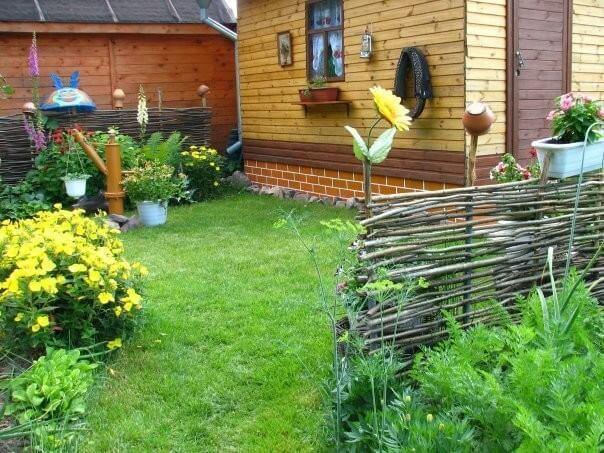
The fence is a fence of woven sticks and branches, which can act as decor, for example, flower beds.There are different ways of weaving, from which everyone can choose for themselves the best:
Flat fence (hedge or fence). Made from twigs sections. One section in length is approximately 2 meters, height is not limited. Ready wicker fence (height above 70 cm) is placed on the already prepared base. Wicker fence (height less than 70 cm). This product is also fixed on the prepared base, but you can do without it. There is a possibility of installation on a special metal base, whereby the time of operation is much increased, and the appearance of the hedge remains unchanged. Rounded fences are divided into braided and ready: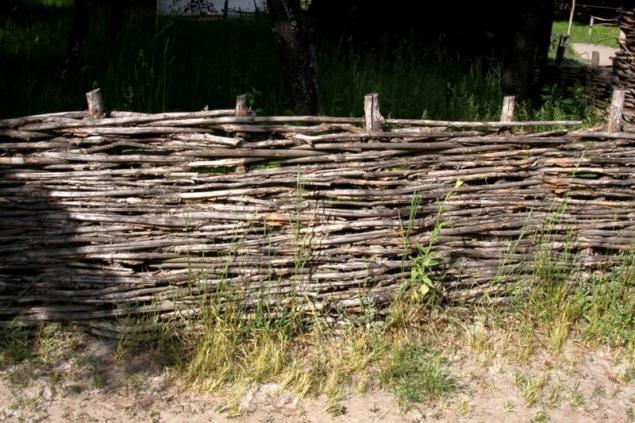
Fence is the most frequently occurring product made of wicker, hand made. It can serve as a shelter from the sun for summer dining or places to stay or decoration of flower beds and paths. Importantly, such a fence will be harmonious with the style of your site. Besides wicker fence is the most simple and easy to perform kinds of fences.
The technique of weavingto make a DIY fence, you don't need skills for laying stone or brick. It does not require investment of large material resources. And the time required for its construction, is comparable small. The technique of weaving is quite simple and does not require any special tools.
Of the tools you will need:
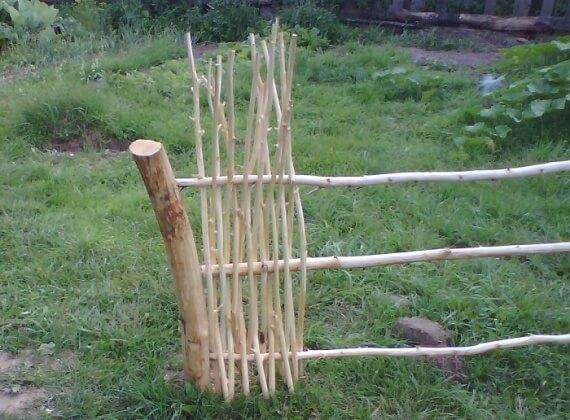
First you need to prepare the material. You can cut the excess branches on the site. But remember to trim the branches without harming the trees, you need to do it in January. Branches you can buy at most nurseries, they're sold in bundles. For weaving of fence are best suited the willow branches, you can make a fence with their hands, and from twigs of birch, Apple, dogwood. Will look very nice if you make it from the branches of various plants.
The next step is to install the upright stakes driven into the ground at approximately the same distance. If you use wooden stakes, it will greatly reduce the life of your fence – it's no secret that wood rot. Therefore, the most correct to use the bars of metal, old pipes and any other unnecessary things that will be useful for construction. If you decide to use wooden stakes, then be sure to consider their treatment with antiseptics. Recommend making a drainage trench where the fence, and instead of regular soil to use sand. Pegs dig in to the ground at a convenient depth. The main thing is to frame the rod is not hanging. At the beginning and at the end of the fence put a vertical stake as close as possible. They serve as the “castle”.
When everything's done, you can proceed to the next step. Divide the rods on thick and thin. Weaves thick bars at the bottom and top and thin in the middle. Below the bars appeared the juice, they're pre-soaked. If this is not done, they become quite flexible and you don't get close to weave the rods. Below branches are well bent, you need to make it a steam bath. Then, when the branches dry, they will become durable.

Do the braiding with their hands. It must be remembered that begin to weave you need from a thick end to the thin branches. It is important not to move all the time in one direction, it is necessary to evenly distribute the pegs are thin and thick ends of the rods. The best option would be to connect the end rods in the upper part, it can use annealed wire. For braiding take from the earth. Turns every twig use boot between the stakes. Excess parts of the rods should be cut. Try to keep branches that are located on the bottom did not fall and did not go to the ground. To do this, the bottom row of branches fasten with wire or nail small nails to horizontally hammered the stakes. To the branches near the top, did not rise, you can secure them also.When everything's done, you can proceed to the next step. Divide the rods on thick and thin. Weaves thick bars at the bottom and top and thin in the middle. Below the bars appeared the juice, they're pre-soaked. If this is not done, they become quite flexible and you don't get close to weave the rods. Below branches are well bent, you need to make it a steam bath. Then, when the branches dry, they will become durable.
SUBSCRIBE to OUR youtube channel that allows you to watch online, download from YouTube free video about the recovery, the rejuvenation of man. Love for others and ourselves, as the feeling of high vibrations — an important factor for improvement .
http://cdn00.vidyomani.com/c/5/2/7/g3ebwxf08bft/index.html
Put LIKES and share with your FRIENDS!
www.youtube.com/channel/UCXd71u0w04qcwk32c8kY2BA/videos
Subscribe -https://www.facebook.com//
Now you can make the final touches in making the fence. A fence made with your own hands, you can decorate clay pots, mugs. And if along your fence to plant corn or sunflowers, your site will be transformed beyond recognition. published
P. S. And remember, only by changing their consumption — together we change the world! ©
Join us in Facebook , Vkontakte, Odnoklassniki
Source: zavorota.ru/montazh/pleten-iz-vetok.html

The fence is a fence of woven sticks and branches, which can act as decor, for example, flower beds.There are different ways of weaving, from which everyone can choose for themselves the best:
Flat fence (hedge or fence). Made from twigs sections. One section in length is approximately 2 meters, height is not limited. Ready wicker fence (height above 70 cm) is placed on the already prepared base. Wicker fence (height less than 70 cm). This product is also fixed on the prepared base, but you can do without it. There is a possibility of installation on a special metal base, whereby the time of operation is much increased, and the appearance of the hedge remains unchanged. Rounded fences are divided into braided and ready:
- ready beds – in diameter up to 100 cm, collected with a ready mount (for fixing into the ground);
- weave the place is the products, which exceed in diameter 100 cm, in the form of beds around the already growing plants.

Fence is the most frequently occurring product made of wicker, hand made. It can serve as a shelter from the sun for summer dining or places to stay or decoration of flower beds and paths. Importantly, such a fence will be harmonious with the style of your site. Besides wicker fence is the most simple and easy to perform kinds of fences.
The technique of weavingto make a DIY fence, you don't need skills for laying stone or brick. It does not require investment of large material resources. And the time required for its construction, is comparable small. The technique of weaving is quite simple and does not require any special tools.
Of the tools you will need:
- pruner or shear wood – to cut the bars;
- hacksaw to saw off the horizontal pegs to a comfortable length;
- shovel – to dig the hole for your peg horizontal;
- pliers – to branches to secure and pull wire;
- hammer with nails – an alternative solution to secure the branches to the stakes driven into.

First you need to prepare the material. You can cut the excess branches on the site. But remember to trim the branches without harming the trees, you need to do it in January. Branches you can buy at most nurseries, they're sold in bundles. For weaving of fence are best suited the willow branches, you can make a fence with their hands, and from twigs of birch, Apple, dogwood. Will look very nice if you make it from the branches of various plants.
The next step is to install the upright stakes driven into the ground at approximately the same distance. If you use wooden stakes, it will greatly reduce the life of your fence – it's no secret that wood rot. Therefore, the most correct to use the bars of metal, old pipes and any other unnecessary things that will be useful for construction. If you decide to use wooden stakes, then be sure to consider their treatment with antiseptics. Recommend making a drainage trench where the fence, and instead of regular soil to use sand. Pegs dig in to the ground at a convenient depth. The main thing is to frame the rod is not hanging. At the beginning and at the end of the fence put a vertical stake as close as possible. They serve as the “castle”.
When everything's done, you can proceed to the next step. Divide the rods on thick and thin. Weaves thick bars at the bottom and top and thin in the middle. Below the bars appeared the juice, they're pre-soaked. If this is not done, they become quite flexible and you don't get close to weave the rods. Below branches are well bent, you need to make it a steam bath. Then, when the branches dry, they will become durable.

Do the braiding with their hands. It must be remembered that begin to weave you need from a thick end to the thin branches. It is important not to move all the time in one direction, it is necessary to evenly distribute the pegs are thin and thick ends of the rods. The best option would be to connect the end rods in the upper part, it can use annealed wire. For braiding take from the earth. Turns every twig use boot between the stakes. Excess parts of the rods should be cut. Try to keep branches that are located on the bottom did not fall and did not go to the ground. To do this, the bottom row of branches fasten with wire or nail small nails to horizontally hammered the stakes. To the branches near the top, did not rise, you can secure them also.When everything's done, you can proceed to the next step. Divide the rods on thick and thin. Weaves thick bars at the bottom and top and thin in the middle. Below the bars appeared the juice, they're pre-soaked. If this is not done, they become quite flexible and you don't get close to weave the rods. Below branches are well bent, you need to make it a steam bath. Then, when the branches dry, they will become durable.
SUBSCRIBE to OUR youtube channel that allows you to watch online, download from YouTube free video about the recovery, the rejuvenation of man. Love for others and ourselves, as the feeling of high vibrations — an important factor for improvement .
http://cdn00.vidyomani.com/c/5/2/7/g3ebwxf08bft/index.html
Put LIKES and share with your FRIENDS!
www.youtube.com/channel/UCXd71u0w04qcwk32c8kY2BA/videos
Subscribe -https://www.facebook.com//
Now you can make the final touches in making the fence. A fence made with your own hands, you can decorate clay pots, mugs. And if along your fence to plant corn or sunflowers, your site will be transformed beyond recognition. published
P. S. And remember, only by changing their consumption — together we change the world! ©
Join us in Facebook , Vkontakte, Odnoklassniki
Source: zavorota.ru/montazh/pleten-iz-vetok.html

